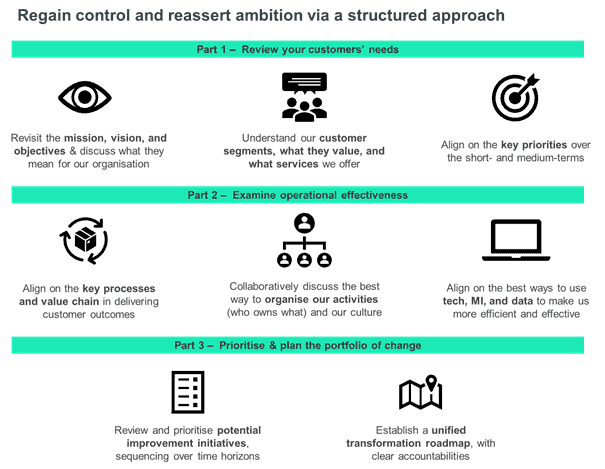By David Cass, Partner, Sia Partners UK & Ireland
How has your organisation coped over the past 18 months? Are you building back the core capabilities as demand returns? Are you fixing the issues caused by growth at break-neck speed which strained your people, processes, and technology? Or have you been taking tactical decisions to simply stay one step ahead, while putting larger transformations or changes on hold?
Wherever you may find yourself, you are not alone. Many companies are facing what we call organisational overwhelm – when multiple pressures and challenges overtake the organisation’s ability to assess change needs, decide key priorities, and then act.
Four outcomes of organisational overwhelm
Massively parallel, disconnected change
Tactical initiatives take the place of co-ordinated strategic change – resulting in pockets of good practice but delivering poor enterprise wide consictency, fatigue and morale issues due to the constant and sometimes conflicting change workload.
Inability to keep pace with changing expectations
Both consumers and employees have adapted what they expect from companies. Organisations are now finding out that customers and employees’ willingness to leave organisations that fall short of expectations is at an all-time high.
Failure to innovate
Organisations, and individuals, have a challenging time thinking creatively or strategically when under significant pressure. Organisations sitting on top of a treasure trove of customer or market data often fail to effectively use it to give context to decisions or to optimise services.
Losing your “North Star”
Focus is tactical and away from the longer-term business ambition, and the consequence can be that the consensus around a future that your leadership team shared has dissipated. It is time to realign and reinforce leadership commitment.
How to address organisational overwhelm

We recommend starting by conducting a short, sharp review of your enterprise, business unit, or function via a structured process:
Part 1. Review your customers’ needs
Understand how these have changed, what services and products would best meet these needs, and what can you do to create that offering. Challenge your team to “delight” customers. Re-establish your ambition for market success.
Part 2. Examine operational effectiveness
Are current capabilities effective and where are the gaps? Undertake a structured review of process, organisation, technology, and data. Consider the potential for data driven interventions to create new sources of value in the future.
Part 3. Prioritise & plan the portfolio of change
Form a balanced and sequenced portfolio of initiatives tied to outcomes over time.
As the world returns to a new normal, make the time to reassert your ambition, re-engage your extended leadership team, and re-examine the fundamental changes your business needs to make. This approach does not require a halt to operations but it does require support from your leadership to give employees time and space to diagnose and problem-solve.
About the authors:
Sia Partners Ireland has been helping to reduce complexity and costs in Irish Businesses for over 16 years. Our innovative approach and highly experienced team provide pragmatic solutions that can be implemented in an agile manner. As part of a global team of 2800 in 40 offices worldwide we are a next-generation consulting firm and leverage a unique blend of Digital, AI and design capabilities, augmenting traditional consulting to deliver superior value and tangible results to our clients.

